During Asian American and Pacific Islander Heritage (AAPIH) Month in May, Emory Libraries will take a look at AAPI history in the US and our Libraries’ relevant resources.
Despite a long history of immigrants from Asia contributing to the economy, culture, and history of the United States, the term “Asian American” is more recent than you might expect. Yuji Ichioka, a student at the University of California Berkeley, coined the term in 1968 to unite various immigrant groups of Asian origin under a common banner. Previously, such immigrants tended to consider themselves distinct groups according to the countries from which they immigrated, but Ichioka and others saw the potential for collaboration between people from Japan, the Philippines, Vietnam, and elsewhere on social and political issues.
Amid the turbulent 1960s, when movements for the rights of African Americans, gays, women, and other marginalized groups dominated the national discourse, the efforts of Asian Americans were often overshadowed. In the years since, scholars have used numerous sources to tell the story of what is now known as the Asian American movement.
Collective activism among Asian Americans first took place on college campuses in the 1960s, where organizers drew inspiration from the Black Power movement, often after having participated in it firsthand. Student groups like the Asian American Political Alliance (a name used by organizations on both the East and West coasts) demonstrated to raise awareness of poor living and economic conditions in Asian communities and to demand an end to the prejudice that kept those of Asian descent from fully participating in American society. Demonstrations directed at university faculty and administrators led to the establishment of early ethnic studies programs in higher education, and efforts outside of academia aimed to provide social services and encourage political action in local neighborhoods.
While local groups focused on local concerns, and divisions were born from the differing motivations of various ethnicities and political alignments, there were overarching issues that bridged divides between groups. One was the Vietnam War, which activists saw as both an example of imperialist American policy as well as an extension of anti-Asian racism beyond America’s borders. Another was the renewal of the US-Japan Security Treaty, which was criticized as a means for America to widen the reach of its military via troops and bases even as Japan’s use of force was prohibited by its constitution. In calling out a common impetus behind the discrimination they faced at home and America’s tactics overseas, Asian Americans forged solidarity not only between themselves—who, notably, were at risk of becoming directly involved due to conscription—but also with citizens of the nations where the US military operated.
One of the lasting impacts of Asian American activism in the 1960s-70s was the creation of a sense of identity through art and culture. Negative stereotypes about Asians perpetuated in the media were readily applied to Asian Americans, who debated internally the value of attempting to integrate with a society that excluded them. At the same time, their longstanding presence in America had estranged them from the cultures of their homelands. This dichotomy was the subject of theater productions, written publications, and works of visual art created by Asian Americans, who sought to take the construction of their identity into their own hands. Art was thus an essential part of the broader social justice aims of the movement, which observances such as Asian American and Pacific Islander Heritage Month continue to make known today.
To find resources about the Asian American movement at the Emory Libraries via our online catalog, try performing an advanced search. Enter “Asian Americans” in the subject field along with a more specific topical term, as below:
Asian Americans – Ethnic identity
Asian Americans – Political activity
Asian Americans – Politics and government
Asian Americans – Social conditions
Related subjects that are more general, such as United States – Race relations or Student movements may be useful as well. Also note that the subjects that appear in search results are links to lists of other materials with the same subject. If you find a useful item in the catalog, be sure to click the subject links to find similar items.
The following are selected works in our collection through which you can learn more about the Asian American movement.
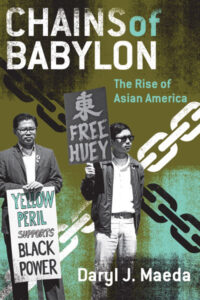 Chains of Babylon: The Rise of Asian America (2009), by Daryl J. Maeda — In “Chains of Babylon,” Daryl J. Maeda presents a cultural history of Asian American activism in the late 1960s and early 1970s, showing how the movement created the category of “Asian American” to join Asians of many ethnicities in racial solidarity. Drawing on the Black Power and antiwar movements, Asian American radicals argued that all Asians in the United States should resist assimilation and band together to oppose racism within the country and imperialism abroad. (From publisher)
Chains of Babylon: The Rise of Asian America (2009), by Daryl J. Maeda — In “Chains of Babylon,” Daryl J. Maeda presents a cultural history of Asian American activism in the late 1960s and early 1970s, showing how the movement created the category of “Asian American” to join Asians of many ethnicities in racial solidarity. Drawing on the Black Power and antiwar movements, Asian American radicals argued that all Asians in the United States should resist assimilation and band together to oppose racism within the country and imperialism abroad. (From publisher)
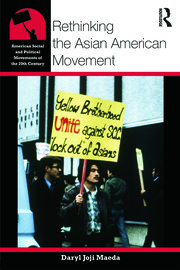 Rethinking the Asian American Movement (2011), by Daryl J. Maeda — Although it is one of the least-known social movements of the 1960s and 1970s, the Asian American movement drew upon some of the most powerful currents of the era, and had a wide-ranging impact on the political landscape of Asian America, and more generally, the United States. Using the racial discourse of the Black power and other movements, as well as antiwar activist and the global decolonization movements, the Asian American movement succeeded in creating a multi-ethnic alliance of Asians in the United States and gave them a voice in their own destinies. “Rethinking the Asian American Movement” provides a short, accessible overview of this important social and political movement, highlighting key events and key figures, the movement’s strengths and weaknesses, how it intersected with other social and political movements of the time, and its lasting effect on the country. It is perfect for anyone wanting to obtain an introduction to the Asian American movement of the 20th century. (from publisher)
Rethinking the Asian American Movement (2011), by Daryl J. Maeda — Although it is one of the least-known social movements of the 1960s and 1970s, the Asian American movement drew upon some of the most powerful currents of the era, and had a wide-ranging impact on the political landscape of Asian America, and more generally, the United States. Using the racial discourse of the Black power and other movements, as well as antiwar activist and the global decolonization movements, the Asian American movement succeeded in creating a multi-ethnic alliance of Asians in the United States and gave them a voice in their own destinies. “Rethinking the Asian American Movement” provides a short, accessible overview of this important social and political movement, highlighting key events and key figures, the movement’s strengths and weaknesses, how it intersected with other social and political movements of the time, and its lasting effect on the country. It is perfect for anyone wanting to obtain an introduction to the Asian American movement of the 20th century. (from publisher)
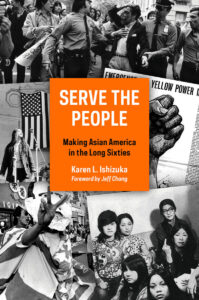 Serve the People: Making Asian America in the Long Sixties (2018), by Karen L. Ishizuka — Drawing on more than 120 interviews and illustrated with striking images from guerrilla movement publications, the book evokes the feeling of growing up alien in a society rendered in black and white, and recalls the intricate memories and meanings of the Asian American movement. “Serve the People” paints a panoramic landscape of a radical time, and is destined to become the definitive history of the making of Asian America. (From publisher)
Serve the People: Making Asian America in the Long Sixties (2018), by Karen L. Ishizuka — Drawing on more than 120 interviews and illustrated with striking images from guerrilla movement publications, the book evokes the feeling of growing up alien in a society rendered in black and white, and recalls the intricate memories and meanings of the Asian American movement. “Serve the People” paints a panoramic landscape of a radical time, and is destined to become the definitive history of the making of Asian America. (From publisher)
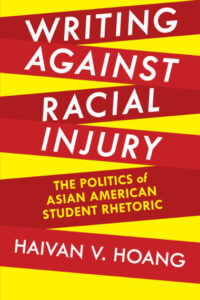 Writing Against Racial Injury: The Politics of Asian American Student Rhetoric (2015), by Haivan V. Hoang — “Writing against Racial Injury” recalls the story of Asian American student rhetoric at the site of language and literacy education in post-1960s California. What emerged in the Asian American movement was a recurrent theme in US history: conflicts over language and literacy difference masked wider racial tensions. Bringing together language and literacy studies, Asian American history and rhetoric, and critical race theory, Hoang uses historiography and ethnography to explore the politics of Asian American language and literacy education: the growth of Asian American student organizations and self-sponsored writing; the ways language served as thinly veiled trope for race in the influential Lau v. Nichols; the inheritance of a rhetoric of injury on college campuses; and activist rhetorical strategies that rearticulate Asian American racial identity. These fragments depict a troubling yet hopeful account of the ways language and literacy education alternately racialized Asian Americans while also enabling rearticulations of Asian American identity, culture, and history. This project, more broadly, seeks to offer educators a new perspective on racial accountability in language and literacy education. (from publisher)
Writing Against Racial Injury: The Politics of Asian American Student Rhetoric (2015), by Haivan V. Hoang — “Writing against Racial Injury” recalls the story of Asian American student rhetoric at the site of language and literacy education in post-1960s California. What emerged in the Asian American movement was a recurrent theme in US history: conflicts over language and literacy difference masked wider racial tensions. Bringing together language and literacy studies, Asian American history and rhetoric, and critical race theory, Hoang uses historiography and ethnography to explore the politics of Asian American language and literacy education: the growth of Asian American student organizations and self-sponsored writing; the ways language served as thinly veiled trope for race in the influential Lau v. Nichols; the inheritance of a rhetoric of injury on college campuses; and activist rhetorical strategies that rearticulate Asian American racial identity. These fragments depict a troubling yet hopeful account of the ways language and literacy education alternately racialized Asian Americans while also enabling rearticulations of Asian American identity, culture, and history. This project, more broadly, seeks to offer educators a new perspective on racial accountability in language and literacy education. (from publisher)
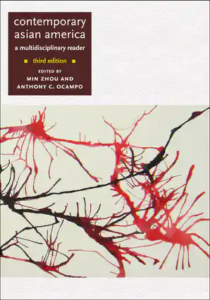 Contemporary Asian America: A Multidisciplinary Reader (2016), edited by Min Zhou and Anthony C. Ocampo — When “Contemporary Asian America” was first published in 2000, it exposed its readers to the formation and development of Asian American studies as an academic field of study, from its inception as part of the ethnic consciousness movement of the 1960s to the systematic inquiry into more contemporary theoretical and practical issues facing Asian America at the century’s end. It was the first volume to integrate a broad range of interdisciplinary research and approaches from a social science perspective to assess the effects of immigration, community development, and socialization on Asian American communities. This updated third edition discusses the impact of September 11 on Asian American identity and citizenship; the continued influence of globalization on past and present waves of immigration; and the intersection of race, gender, sexuality, and class on the experiences of Asian immigrants and their children. The volume also provides study questions and recommended supplementary readings and documentary films. This critical text offers a broad overview of Asian American studies and the current state of Asian America. (from publisher)
Contemporary Asian America: A Multidisciplinary Reader (2016), edited by Min Zhou and Anthony C. Ocampo — When “Contemporary Asian America” was first published in 2000, it exposed its readers to the formation and development of Asian American studies as an academic field of study, from its inception as part of the ethnic consciousness movement of the 1960s to the systematic inquiry into more contemporary theoretical and practical issues facing Asian America at the century’s end. It was the first volume to integrate a broad range of interdisciplinary research and approaches from a social science perspective to assess the effects of immigration, community development, and socialization on Asian American communities. This updated third edition discusses the impact of September 11 on Asian American identity and citizenship; the continued influence of globalization on past and present waves of immigration; and the intersection of race, gender, sexuality, and class on the experiences of Asian immigrants and their children. The volume also provides study questions and recommended supplementary readings and documentary films. This critical text offers a broad overview of Asian American studies and the current state of Asian America. (from publisher)
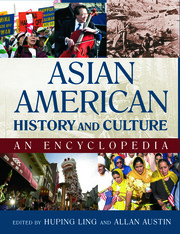 Asian American History and Culture: An Encyclopedia (2015), edited by Huping Ling and Allan Austin — With overview essays and more than 400 A-Z entries, this exhaustive encyclopedia documents the history of Asians in America from earliest contact to the present day. Organized topically by group, with an in-depth overview essay on each group, the encyclopedia examines the myriad ethnic groups and histories that make up the Asian American population in the United States. “Asian American History and Culture” covers the political, social, and cultural history of immigrants from East Asia, Southeast Asia, South Asia, the Pacific Islands, and their descendants, as well as the social and cultural issues faced by Asian American communities, families, and individuals in contemporary society. In addition to entries on various groups and cultures, the encyclopedia also includes articles on general topics such as parenting and child rearing, assimilation and acculturation, business, education, and literature. (from publisher)
Asian American History and Culture: An Encyclopedia (2015), edited by Huping Ling and Allan Austin — With overview essays and more than 400 A-Z entries, this exhaustive encyclopedia documents the history of Asians in America from earliest contact to the present day. Organized topically by group, with an in-depth overview essay on each group, the encyclopedia examines the myriad ethnic groups and histories that make up the Asian American population in the United States. “Asian American History and Culture” covers the political, social, and cultural history of immigrants from East Asia, Southeast Asia, South Asia, the Pacific Islands, and their descendants, as well as the social and cultural issues faced by Asian American communities, families, and individuals in contemporary society. In addition to entries on various groups and cultures, the encyclopedia also includes articles on general topics such as parenting and child rearing, assimilation and acculturation, business, education, and literature. (from publisher)
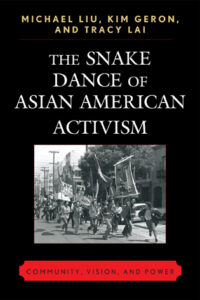 The Snake Dance of Asian American Activism: Community, Vision, and Power (2008) by Michael Liu, Kim Geron, and Tracy Lai — This text reinterprets a misunderstood and overlooked epoch of the Asian American experience, the Asian American movement (AAM). The authors argue that, contrary to the common view of the movement as a passing phase limited to college youth, the Asian American movement spanned diverse political viewpoints and became increasingly sophisticated and effective. Asian Americans were active participants and played unique roles in the social movements that convulsed the 1960s and 1970s, particularly in protests against the Vietnam War. The book traces the history of the AAM from its roots in the 1930s to the present day and its impact on diverse areas of the Asian American community. Most importantly, it looks at the societal and community dynamics that led to the movement’s trajectory. Using the lens of social movement theory, it analyzes the AAM’s rise and ebb and possible resurgence. The authors argue that the AAM constituted a distinct, identifiable, and relatively stable social movement that dramatically impacted the direction of Asian American political and social activity. (from publisher)
The Snake Dance of Asian American Activism: Community, Vision, and Power (2008) by Michael Liu, Kim Geron, and Tracy Lai — This text reinterprets a misunderstood and overlooked epoch of the Asian American experience, the Asian American movement (AAM). The authors argue that, contrary to the common view of the movement as a passing phase limited to college youth, the Asian American movement spanned diverse political viewpoints and became increasingly sophisticated and effective. Asian Americans were active participants and played unique roles in the social movements that convulsed the 1960s and 1970s, particularly in protests against the Vietnam War. The book traces the history of the AAM from its roots in the 1930s to the present day and its impact on diverse areas of the Asian American community. Most importantly, it looks at the societal and community dynamics that led to the movement’s trajectory. Using the lens of social movement theory, it analyzes the AAM’s rise and ebb and possible resurgence. The authors argue that the AAM constituted a distinct, identifiable, and relatively stable social movement that dramatically impacted the direction of Asian American political and social activity. (from publisher)
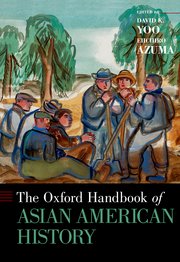 The Oxford Handbook of Asian American History (2016), edited by David K. Yoo and Eiichiro Azuma — In this volume, 30 leading scholars offer original essays on a wide range of topics. The chapters trace Asian American history from the beginning of the migration flows toward the Pacific Islands and the American continent to Japanese American incarceration and Asian American participation in World War II, from the experience of exclusion, violence, and racism to the social and political activism of the late twentieth century. The authors explore many of the key aspects of the Asian American experience, including politics, economy, intellectual life, the arts, education, religion, labor, gender, family, urban development, and legal history. (from publisher)
The Oxford Handbook of Asian American History (2016), edited by David K. Yoo and Eiichiro Azuma — In this volume, 30 leading scholars offer original essays on a wide range of topics. The chapters trace Asian American history from the beginning of the migration flows toward the Pacific Islands and the American continent to Japanese American incarceration and Asian American participation in World War II, from the experience of exclusion, violence, and racism to the social and political activism of the late twentieth century. The authors explore many of the key aspects of the Asian American experience, including politics, economy, intellectual life, the arts, education, religion, labor, gender, family, urban development, and legal history. (from publisher)
 Asian American History: A Very Short Introduction (2017), by Madeline Y. Hsu — A 2012 survey by the Pew Research Center reported that Asian Americans are the best-educated, highest-income, and best-assimilated racial group in the United States. Before reaching this level of economic success and social assimilation, however, Asian immigrants’ path was full of difficult, even demeaning, moments. This book provides a sweeping and nuanced history of Asian Americans, revealing how and why the perception of Asian immigrants changed over time. Asian migrants, in large part Chinese, arrived in significant numbers on the West Coast during the 1850s and 1860s to work in gold mining and on the construction of the transcontinental Railroad. Unlike their contemporary European counterparts, Asians, often stigmatized as “coolies,” challenged American ideals of equality with the problem of whether all racial groups could be integrated into America’s democracy. The fear of the “Yellow Peril” soon spurred an array of legislative and institutional efforts to segregate them through immigration laws, restrictions on citizenship, and limits on employment, property ownership, access to public services, and civil rights. Prejudices against Asian Americans reached a peak during World War II, when Japanese Americans were interned en masse. It was only with changes in the immigration laws and the social and political activism of the 1960s and 1970s that Asian Americans gained ground and acceptance, albeit in the still stereotyped category of “model minorities.” Madeline Y. Hsu weaves a fascinating historical narrative of this “American Dream.” She shows how Asian American success, often attributed to innate cultural values, is more a result of the immigration laws, which have largely pre-selected immigrants of high economic and social potential. Asian Americans have, in turn, been used by politicians to bludgeon newer (and more populous) immigrant groups for their purported lack of achievement. Hsu deftly reveals how public policy, which can restrict and also selectively promote certain immigrant populations, is a key reason why some immigrant groups appear to be more naturally successful and why the identity of those groups evolves differently from others. (from publisher)
Asian American History: A Very Short Introduction (2017), by Madeline Y. Hsu — A 2012 survey by the Pew Research Center reported that Asian Americans are the best-educated, highest-income, and best-assimilated racial group in the United States. Before reaching this level of economic success and social assimilation, however, Asian immigrants’ path was full of difficult, even demeaning, moments. This book provides a sweeping and nuanced history of Asian Americans, revealing how and why the perception of Asian immigrants changed over time. Asian migrants, in large part Chinese, arrived in significant numbers on the West Coast during the 1850s and 1860s to work in gold mining and on the construction of the transcontinental Railroad. Unlike their contemporary European counterparts, Asians, often stigmatized as “coolies,” challenged American ideals of equality with the problem of whether all racial groups could be integrated into America’s democracy. The fear of the “Yellow Peril” soon spurred an array of legislative and institutional efforts to segregate them through immigration laws, restrictions on citizenship, and limits on employment, property ownership, access to public services, and civil rights. Prejudices against Asian Americans reached a peak during World War II, when Japanese Americans were interned en masse. It was only with changes in the immigration laws and the social and political activism of the 1960s and 1970s that Asian Americans gained ground and acceptance, albeit in the still stereotyped category of “model minorities.” Madeline Y. Hsu weaves a fascinating historical narrative of this “American Dream.” She shows how Asian American success, often attributed to innate cultural values, is more a result of the immigration laws, which have largely pre-selected immigrants of high economic and social potential. Asian Americans have, in turn, been used by politicians to bludgeon newer (and more populous) immigrant groups for their purported lack of achievement. Hsu deftly reveals how public policy, which can restrict and also selectively promote certain immigrant populations, is a key reason why some immigrant groups appear to be more naturally successful and why the identity of those groups evolves differently from others. (from publisher)
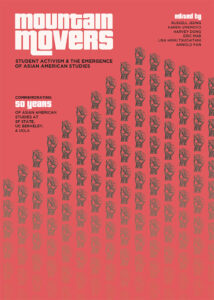 Mountain Movers: Student Activism and the Emergence of Asian American Studies (2019) — This book shares the narratives of nine remarkable students. For each of these Asian Americans, their ethnic heritages and racialized experiences, their family backgrounds, their education, and the social movements of their day intersected so that they became agents of change. Specifically, they organized and mobilized fellow students and community members to establish and further Asian American Studies (AAS) on their campuses. AAS has since grown not only to offer a relevant curriculum for and about these students, but also to help develop and empower their communities. With accounts of the development of AAS at San Francisco State University, UC Berkeley, and UCLA, Mountain Movers highlights how students have changed the course of history. (from publisher)
Mountain Movers: Student Activism and the Emergence of Asian American Studies (2019) — This book shares the narratives of nine remarkable students. For each of these Asian Americans, their ethnic heritages and racialized experiences, their family backgrounds, their education, and the social movements of their day intersected so that they became agents of change. Specifically, they organized and mobilized fellow students and community members to establish and further Asian American Studies (AAS) on their campuses. AAS has since grown not only to offer a relevant curriculum for and about these students, but also to help develop and empower their communities. With accounts of the development of AAS at San Francisco State University, UC Berkeley, and UCLA, Mountain Movers highlights how students have changed the course of history. (from publisher)
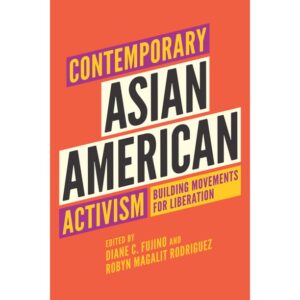 Contemporary Asian American Activism: Building Movements for Liberation (2022), edited by Diane C. Fujino and Robyn M. Rodriquez — In the struggles for prison abolition, global anti-imperialism, immigrant rights, affordable housing, environmental justice, fair labor, and more, twenty-first-century Asian American activists are speaking out and standing up to systems of oppression. Creating emancipatory futures requires collective action and reciprocal relationships that are nurtured over time and forged through cross-racial solidarity and intergenerational connections, leading to a range of on-the-ground experiences. Bringing together grassroots organizers and scholar-activists, Contemporary Asian American Activism presents lived experiences of the fight for transformative justice and offers lessons to ensure the longevity and sustainability of organizing. In the face of imperialism, white supremacy, racial capitalism, heteropatriarchy, ableism, and more, the contributors celebrate victories and assess failures, reflect on the trials of activist life, critically examine long-term movement building, and inspire continued mobilization for coming generations. (from publisher)
Contemporary Asian American Activism: Building Movements for Liberation (2022), edited by Diane C. Fujino and Robyn M. Rodriquez — In the struggles for prison abolition, global anti-imperialism, immigrant rights, affordable housing, environmental justice, fair labor, and more, twenty-first-century Asian American activists are speaking out and standing up to systems of oppression. Creating emancipatory futures requires collective action and reciprocal relationships that are nurtured over time and forged through cross-racial solidarity and intergenerational connections, leading to a range of on-the-ground experiences. Bringing together grassroots organizers and scholar-activists, Contemporary Asian American Activism presents lived experiences of the fight for transformative justice and offers lessons to ensure the longevity and sustainability of organizing. In the face of imperialism, white supremacy, racial capitalism, heteropatriarchy, ableism, and more, the contributors celebrate victories and assess failures, reflect on the trials of activist life, critically examine long-term movement building, and inspire continued mobilization for coming generations. (from publisher)
by Lawrence Hamblin, Japanese and Korean Studies librarian

